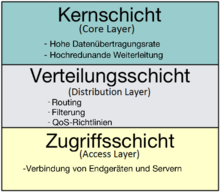Hierarchical internetworking model
The hierarchical internetworking model (also known as the three-tier model ) is a network design model. The three-tier model divides corporate networks into three tiers: core, distribution and access tier. Each layer offers different services for end devices and servers .
Core layer
The core layer offers high data transmission rates, highly redundant forwarding in order to move packets between distribution layer devices in different regions of the network. Core switches and routers tend to be the most powerful in terms of forwarding. In enterprises, core network devices manage high-speed connections such as 10 Gigabit Ethernet .
Distribution layer
The distribution layer is the “intelligent” middle layer in the three-tier model. Routing , filtering and QoS policies are managed in the distribution layer. Distribution layer devices also often manage individual branches of the WAN links. This layer is also called the workgroup layer .
Access layer
End devices and servers connect to the company at the access layer . Devices of the access layer are usually switches . The focus on the access layer is the cost optimization per port. This layer is also called the desktop layer because it focuses on connecting client nodes, such as workstations , to the network.
literature
- Stefan Freischlad: Development and testing of the didactic system internetworking in computer science classes. Universitätsverlag Potsdam, Potsdam 2010, ISBN 978-3-86956-058-8 .
See also
Web links
- Basics of computer networks (accessed July 31, 2017)
- Computer networks (accessed on July 31, 2017)
